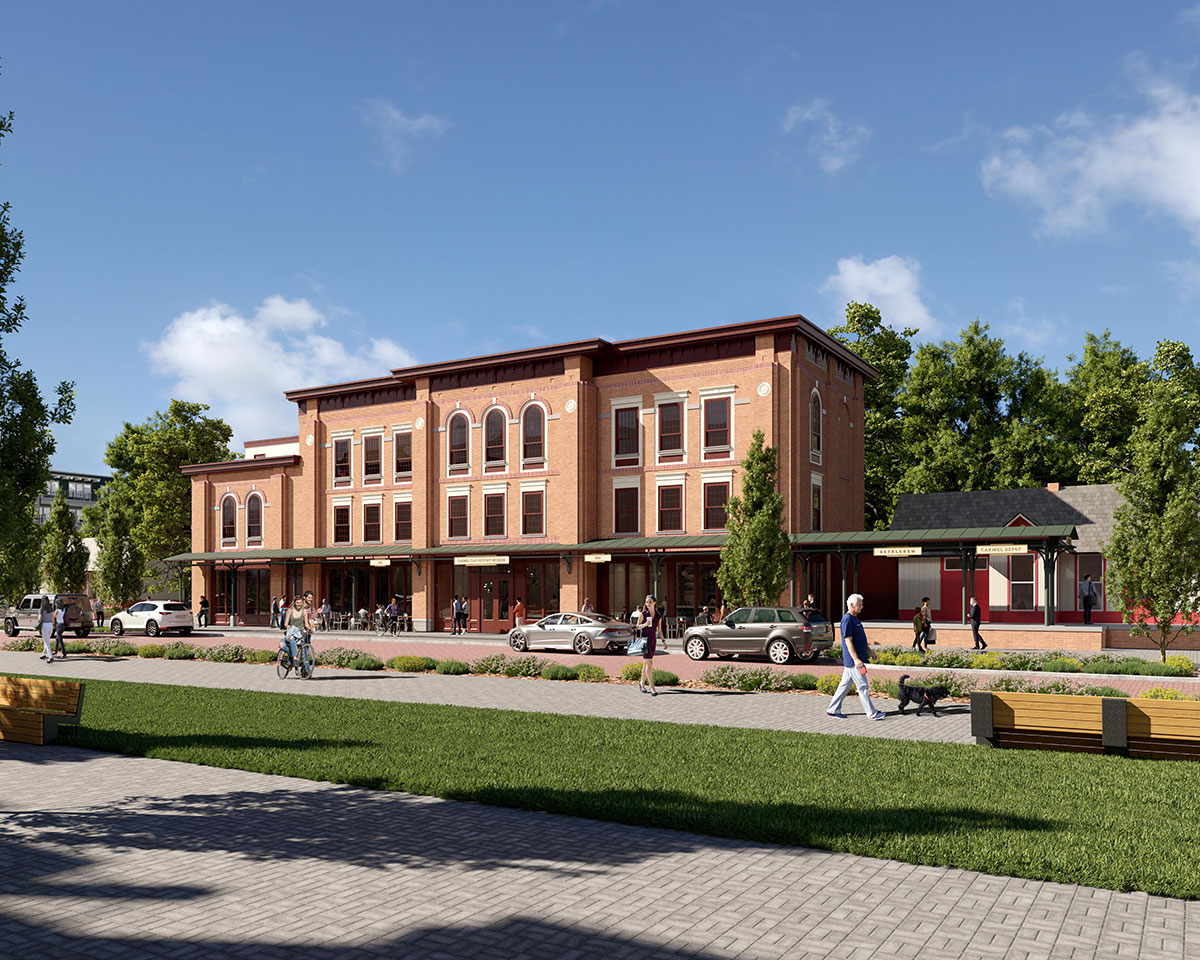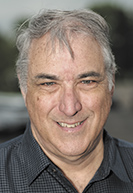Subscriber Benefit
As a subscriber you can listen to articles at work, in the car, or while you work out. Subscribe NowA museum focused on Carmel’s past will soon rise in one of the city’s newest districts.
The Carmel Clay Historical Society broke ground in June on the Carmel Clay History Museum. The 10,000-square-foot museum will be at the southwest corner of First Street SW and Monon Boulevard, along the border between Midtown and the Arts & Design District.
Carmel-based Studio M Architecture & Planning designed the museum that is expected to open late next year or in early 2025.
“Carmel has more history than people give it credit for,” Carmel Clay Historical Society Executive Director Debbie Gangstad told IBJ. “We’ve evolved from that small, little rural town that really was one of the smallest in Hamilton County. It’s made a jump, and there were a lot of stories in between that place and where we are now.”
A big part of Carmel’s story is its growth in terms of population and wealth, and the museum will help document that.
The community had a population of only 1,442 in 1960, according to the U.S. Census Bureau. From 1995 to today, it has grown from about 30,000 residents to more than 100,000. The city is also home to more than 150 corporate headquarters.
The museum’s construction will be funded with a $4 million grant from Clay Township and $1.5 million from the Carmel Redevelopment Commission.
The Carmel Clay Historical Society is raising money to fund interior construction, including exhibit space, and has $1.5 million in pledges.
The three-story museum will include a bookstore/gift shop, cafe and exhibit space on the first floor, ticketed historical galleries and exhibits on the second floor, offices on the third floor, and a rooftop garden that can host events, including parties and wedding receptions.
Carmel’s city archives will be stored in a 1,750-square-foot, two-story structure on the south end of the museum with access from the museum’s first and second floors.
The Monon Depot, built in 1883 as Carmel’s stop on the Monon Railroad, will be attached to the museum and house a permanent train exhibit.
“We want people to really enjoy the experience. We want them to come into the museum and really embrace it,” said Dan McFeely, former president of the Carmel Clay Historical Society’s board and a city spokesman. “This is not going to be your typical small-town historical society museum. We plan to be open every day. We plan to offer something for every age level every day, and I think that’s important.”
The building’s exterior will be designed to look like a turn-of-the-20th-century brick and steel industrial building.
“That new building looks like it should be the home of a historical society. That’s purposeful,” Carmel Director of Redevelopment Henry Mestetsky said. “It fits the industrial vibe of Midtown while clearly being an incredibly distinct civic building.”
Midtown, a formerly blighted industrial area straddling the Monon Trail west of South Rangeline Road, was built to bridge development between Carmel’s Arts & Design District to the north and City Center to the south.
Over the past decade, the area has been transformed from abandoned buildings with surface parking lots into multistory apartment, office, retail and parking structures.
Carmel spent about $20 million to widen and transform the Monon through Midtown. The project converted the 12-foot-wide pedestrian-and-bike path into a 140-foot-wide corridor with parking spaces, green space, bike lanes, one-way streets, and a plaza near Sun King Taproom & Distillery (351 Monon Blvd.).
“We wanted very much to stay in that location, which hinders us a little bit on size, but we felt like the depot doesn’t need to be three blocks away,” Gangstad said. “It needs to be right where it was.”

Planning the museum
The Carmel Clay Historical Society was founded in 1975 as interest in history increased in the lead-up to the United States’ bicentennial. It was also a time when the Monon Depot was in disrepair with its railroad abandoned.
The city of Carmel gave the depot to the historical society, which used the building on property north of the current GOAT Tavern as a museum from 1980 until earlier this year. The Monon Depot is listed on the National Register of Historic Places.
An adjacent ranch-style house built in the 1970s and since demolished in preparation for the new museum was used to store city archives. McFeely said the house was not an ideal place to store archives and was not temperature-controlled.
“We had mold. We had rats,” he said. “I mean, it was just not a good situation.”
In preparation for the new museum, the Monon Depot was moved two blocks north to an empty property on Third Avenue SW. The depot will return to the museum site where it will sit behind a raised platform meant to evoke a railroad stop.
The Carmel Clay Historical Society began brainstorming plans for the museum in 2021. Leadership started with a wish list on a large white sheet of paper. Those ideas then went to Studio M Architecture & Planning, which got to work turning ideas into designs.
Historical society leadership traveled to history museums in the region, including the Abraham Lincoln Presidential Library and Museum in Springfield, Illinois, which Mayor Jim Brainard suggested could be a model for Carmel’s history museum.
“This Historical Society Museum will hopefully become a destination place for people to come learn about not just the history of Carmel, [but also] the history of Hamilton County, the history of north central Indiana, and we want to be a complement to other historic societies who also do things like this,” McFeely said.
Teaching history
Exhibit space inside the museum will include both permanent and special displays. Studio M is working with Chicago-based Cardosi Kiper Design Group Inc. and Indianapolis-based Hamilton Displays to design the interior.
“I think it’s important for a community like this to keep a link with the root of the community, and hopefully this facility will help achieve those goals,” Studio M founding principal Dan Moriarity said. “There’s a number of things going on in the small building on a small footprint that we’re trying to accommodate.”
David Heighway, a Hamilton County historian at Hamilton East Public Library in Noblesville, said the county’s bicentennial this year boosted residents’ curiousity in the past.
Along with Carmel, Hamilton County communities with historical societies include Arcadia, Fishers, Sheridan and Westfield. The Hamilton County Historical Society in Noblesville is at the county’s former courthouse that was built in 1876 and was the site of Ku Klux Klan Grand Dragon D.C. Stephenson’s murder trial in 1925.
While communities try to be good stewards of their history, Heighway said a city or town’s history museum “tends to be just an old building with lots of old stuff jammed in it.”
“[Carmel is] really upgrading things and trying to organize sort of a professional kind of place,” he said. “And now Carmel is kind of saying, ‘Let’s treat it like a real museum and use the train depot.’”
Gangstad said she is looking forward to exhibits that will educate people about some of Carmel’s historic figures, such as Franklin Booth, an artist who became one of the most prominent illustrators of the first half of the 20th century.
She is also excited about the opportunity to highlight the impact of Quakers in Carmel and cultures taking root more recently.
“We want to also include the new cultures that are coming into our community,” Gangstad said. “We want to learn about them, so I think it’s a place for us to share ideas and give some background, but at the same time, learn, as we’ll all be learning.”•
Please enable JavaScript to view this content.






Make it as big as possible taxpayers are paying the tab. I am sure people from around the world will come to the Museum to learn about Carmel. Have these politicians and there cronies lost their mind?
hahahaha
” I am sure people from around the world will come to the Museum to learn about Carmel.”
LOL. Even in the US, 90% of people can’t pronounce it right.